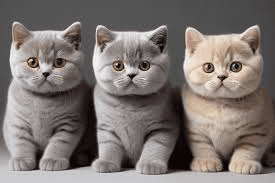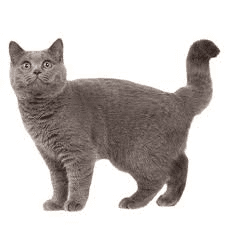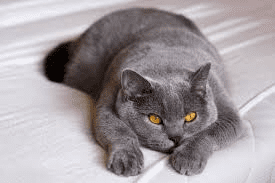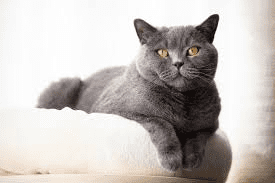The British blue cat, also referred to as the British Shorthair Cat, is a pedigreed and unique breed of domestic cat with a large face, a dense coat, and a noticeably stocky build.
The most well-known color variation is the “British Blue,” which has an all-grey-blue coat, orange eyes, and a medium-sized tail. For the breed, additional hues and patterns such as tabby and colorpoint have also been developed.
The oldest breed of cat in Britain might be the British blue cat. The explanation that is generally regarded as the most likely one is that British blue originated as short-haired street cats and were later developed and standardized to resemble the British blue we know and love today.
At the first official cat show held in England in 1871, British blues were one of the breeds on display. The breed was once known as the British Blue because blue (gray) was a relatively common color in the breed, particularly early on.
British blue shorthair cats are still widely used today and come in a wide range of colors and patterns. The British blue was initially referred to as a domestic shorthair when it was first brought to America in the early 1900s. People can now find this popular breed anywhere in the world.
The British blue appears to be a relatively powerful-looking large cat thanks to its strong, thick-set legs, rounded paws, and medium-length tail with a blunt tip.
The head is quite large and rounded, with a short muzzle, broad cheeks (especially noticeable in adult males, who tend to develop prominent jowls), and large, round eyes that are rich coppery orange in the British Blue but vary in color depending on the coat. Their ears are enormous and widely spaced.
The British Blue variant is frequently confused with the grey Scottish Fold, a breed related to the British blue. The Shorthair can be distinguished by its pointed, triangular ears while the Fold has softer, folded ears.
They take longer to mature than the majority of cat breeds, becoming fully physically mature at around three years of age. Males typically weigh 9-17 lb (4.1-7.7 kg), whereas females typically weigh 7-12 lb (3.2–5.4 kg).
The coat of the British blue breed is one feature that sets it apart, it is extremely dense and has a solid, “crisp” pile that breaks noticeably across the cat’s body when it moves. However, it lacks an undercoat, giving it a plush texture rather than a woolly or fluffy one.
Read Also : Golden British Shorthair Cat Breed Description and Care Guide
Although many different colors and patterns have been developed for British Shorthairs, the British Blue variety is still the most common.
Black, blue, white, red, cream, silver, golden, and, most recently, cinnamon and fawn in solid form as well as in colourpoint, tabby, shaded, and bicolor patterns are all accepted by all official standards. The CFA standard forbids the use of chocolate and its diluted lilac, but the GCCF, FIFe, and TICA do.
Because of their calm demeanor and devotion to their owners despite not being as boisterous and friendly as some other breeds, British blues are a favorite among animal trainers.

They are safe around children and other pets because they generally dislike being picked up or carried, even though they will tolerate some physical contact.
Although they are simple to care for as indoor-only cats and only need light grooming, they are prone to obesity if dietary precautions are not taken.
They are reclusive and wary, but if they have faith in their owners, they will stick by their side and follow them wherever they go. British blue cats are not lap cats.
The British blue cat has a 14–20 year life expectancy, per the UK breed committee. According to legends and researchers, Romans introduced British blue cats to Britain, making them one of the oldest cat breeds still in existence.
British shorthairs were frequently referred to as living teddy bears because of their spherical bodies, velvety coats, and amiable personalities.
The British blue cat is an excellent companion and pet. The British cat will cling to every member of her household out of fierce devotion and adoration.
The British cat likes to play, but doesn’t need constant attention. If they are in the mood to play, they will find someone and a toy. The British can play well alone as well, making them a great friend for single people.
The British blue cat’s diet needs to be carefully controlled because they are thick, muscly cat. Despite their substantial boning and musculature, you should make sure they maintain a healthy weight and stays in good condition. It is very possible that the breed needs interactive play to stay healthy.
If there aren’t any cat toys available, the British will make one out of anything they can find and play whenever they feels like.
In particular as the seasons change and the coat starts to thicken or thin, it is important to brush their hair every day. Even this blue cat is prone to knots if they are not frequently brushed.
The British blues are devoted, but they also like to stay in the sun. The British Shorthair is an easy-to-care-for pet and makes a pleasant, tranquil or peaceful companion.
British Blue Cat Breed Grooming and Care Guide

The British blue requires daily care for healthy skin and fur. Given that this breed of cat has short hair, caring for it is quite easy.
This cat breed is characterized by a short, smooth coat. To keep your cat from consuming too much fur, you must groom it every day. In this way, hairball growth is stopped. Taking care of your British blue will be fun.
Ears should be checked for cleanliness and sensitivity once per week. An ear infection could be brought on by bacteria due to the buildup of wax and grime.
Healthy cats only need the occasional bath with a mild cat shampoo, always try to inquire with your pet’s veterinarian about cleaning the ears. Furthermore, your cat will need dental care.
Giving your British blue cat high-quality cat food and scheduling routine professional dental cleanings with your veterinarian will reduce its risk of developing gingivitis or gum disease.
Little, regular hygiene routines that are very beneficial can be used to maintain healthy skin, healthy teeth, and overall health. Look for environmentally friendly pet products made with natural ingredients.
Trim their nails very carefully, removing only the white tip. By cutting the pink too little rather than too much, you run the risk of inflicting the cat with severe agony or injury. Just the tips of their nails should be cut off.
Gently wipe the area around your cat’s eyes with a cotton ball and a mild salt solution to remove any fluid or mucus buildup. In case the mucus returns, your pet might develop an eye infection. Check your cat’s eyes for any signs of redness, cloudiness, or swelling as well as any wounds.
You should still frequently check your British blue’s nose even though it’s unlikely that it will have any unusual problems. A persistent runny nose in your cat could be brought on by an infection or allergy.
Just like any other cat, your British blue cat could have dental and periodontal problems. You can stop these by regularly brushing their teeth. The ideal frequency for this is once every three days, but once a week is a sufficient minimum.

A good tooth brushing seems to be something that some cats genuinely enjoy. If your British blues falls under the first category, there are ways to significantly lessen the discomfort for both you and your pet during this procedure.
If there is a step in the grooming process that you really struggle with, you can ask your veterinarian for help. Another option is to consult a cat-specific professional cat groomer, who can also offer advice.
Read Also : Products that Can be Derived from Agricultural Waste

